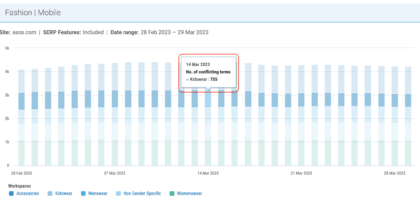Your subdomain strategy could be seriously harming your SEO
18 Jan 2021|7 MIN READ
For all you need to know on cannibalisation, read our complete guide...
Download the complete guide
Is using subdomains affecting your SEO performance? We get asked a lot of questions regarding the usage of subdomains in a URL strategy and site architecture.
- Should I organise my URL structure into subdomains?
- Why are my subdomains conflicting with each other?
- Why is one subdomain appearing in search engines but others are not?
- Should I use subdomains or a subdirectory structure on my site?
- Is a subdomain good for SEO?
- When should you use a subdomain?
- Which is better a subdomain or a subfolder?
In our series of blog posts we’ve identified 4 different types of cannibalisation:
1) Internal SEO cannibalisation
2) Subdomain cannibalisation
3) International site and domain conflict
4) Family site cannibalisation – semantic flux
Here we talk about subdomain cannibalisation and how a legacy strategy of subdomains could seriously be damaging your SEO performance, as the subdomain area cannibalises with the root domain, or indeed other subdomains. Only Pi Datametrics SEO Platform can clearly identify these issues.
Let’s go through the reasons behind using subdomains and the possible issues they create in terms of SEO.
What is a subdomain?
Ok firstly we need to explain what a subdomain is: A URL structure can be based on subdomains or subdirectories stemming from the root domain. A subdomain is a part of another major domain (i.e. the root).
So if the root domain is: https://example.com and people at this business decide they want to have a “News” section they have three basic choices: should i have a subdirectory, subdomain or an entirely new site?
1) Example of a subdirectory https://example.com/news
2) Example of a subdomain https://news.example.com
3) Example of an entirely new URL https://examplenews.com
With the subdomain structure, you can, in theory, go as far as you like, housing multiple subdomains on the same root e.g. company.news.example.com – But ordinarily the subdomain structure would continue with a subfolder after the initial subdomain. e.g. news.example.com/company
By the way, www.example.com is a subdomain of example.com – yes, www. is itself a subdomain.
Subdomain structures:
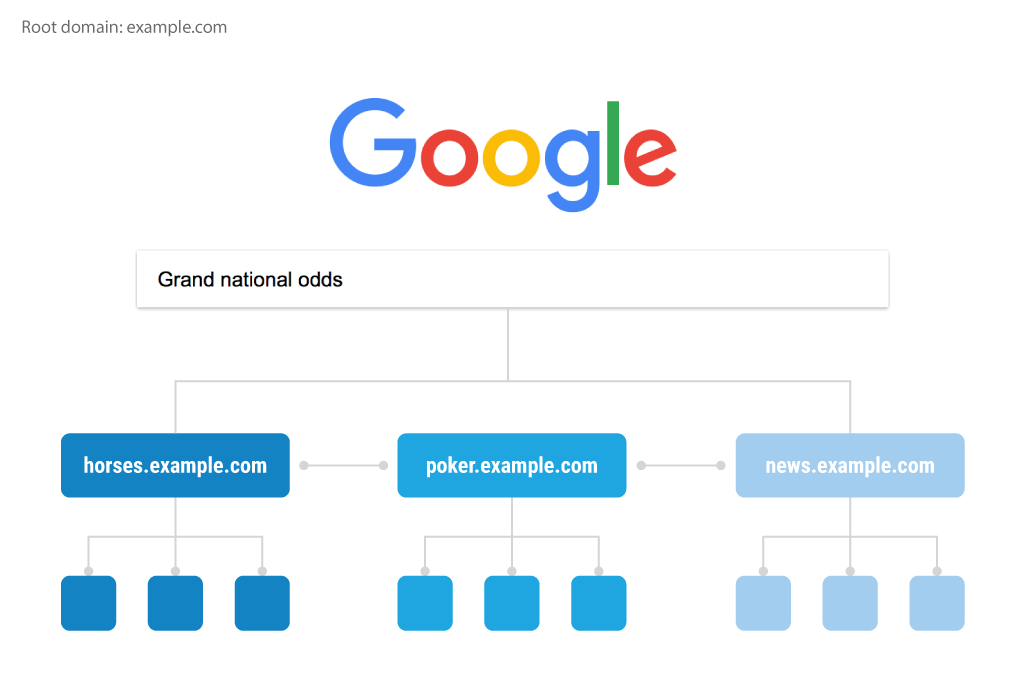 Why would a company use an SEO subdomain strategy?
Why would a company use an SEO subdomain strategy?
A subdomain SEO strategy is a clear way of demarcating a category of content or allocating departments their own space on the root domain. A few years ago many corporations instilled a website strategy based on subdomains, this was done for a few reasons:
- It gave them multiple chances of being found in the search engine results
- They could separate P&Ls across different departments, with separate development teams, content writers, designers etc.
As aforementioned, traffic can be directed to specific sections of the site as a result of a subdomain structure.
This is fine and can work in exactly the same way as a subdirectory. You just need to make sure that the different departments involved don’t duplicate content or theming – just as you would on a subdirectory strategy.
A strategy for Subdomain SEO | The plan:
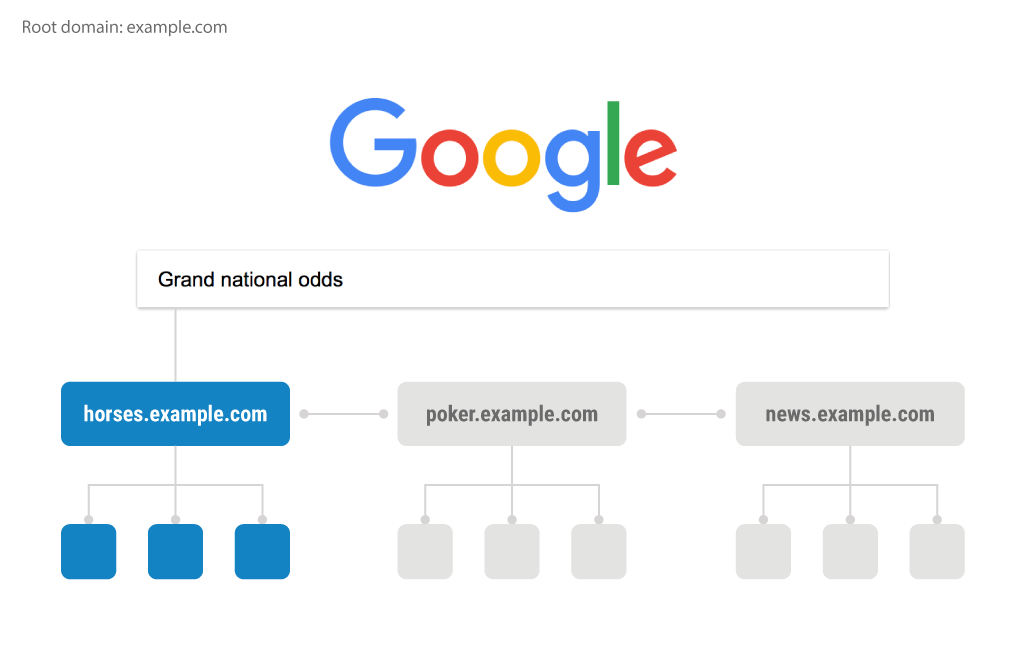
Each segment of a site should be returned for its relevant search term. In this case, the horse racing section should be returned for the ‘Grand National’ related search.
However, subdomain SEO cannibalization can occur when those different departments are focussing on the same content or a search term that is used is very general. This cannibalisation will hamper the site and lose positions. (This can happen with subdirectories too by the way). See example below.
A strategy for Subdomain SEO | The reality: Cannibalisation
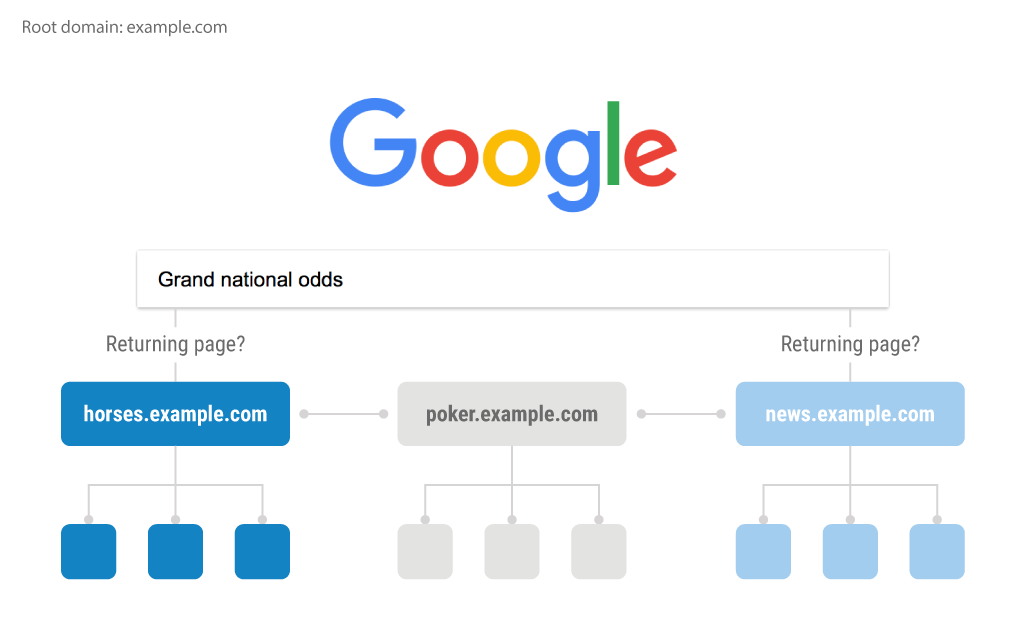
In this example, the news subdomain has written articles about the Grand National, while the horse’s area of the site has a landing page for the grand national. This can lead to subdomain cannibalisation if Google is confused about which page to return.
Cannibalisation: Your complete guide
The history of subdomains: The end of results clustering in Google
In the vast majority of searches, Google will only allow a domain to rank once in the main bulk of the results. Yes, some sites in some searches will achieve multiple places in the top 100 (and may even get two in the top 10) but this is not assured for many of the most competitive searches.
A couple of years ago, Google’s algorithm was misfiring (to say the least) and the results would show multiple results from one site. For example if you did a search for ‘Cheap flights’ almost two-thirds of the top 100 results for this would return the domain cheap-flights.co.uk. This obviously was not right; for both the user (who may have wanted more than just one site to choose from), and for the plethora of businesses that offered cheap flights.
So, obviously the two flaws here were:
1) There were too many results from the same domain offered in the SERPs.
2) There was a higher proliferation of keyword rich domains in the SERPs, including exact match domain (EMD) and partial match domain results (PMD) – meaning that if the search term was featured in the root-domain such as “cheap flights”, Google would give that a far greater weighting.
This flaw in Google’s searches was greatly abused by marketers and SEO practitioners. Many corporations would setup multiple URLs (including subdomains) and purchase as many keyword rich domains as possible. I’ll even admit that I did the same. I went to the Go-Daddy auction pages and bought several sites across multiple industry verticals.
Examples of subdomain cannibalisation
In the same way that no sector is safe from general internal cannibalisation, any site that has used a subdomain structure could face subdomain cannibalisation.
Departmental subdomain cannibalisation
Example: The Gambling sector
The gambling sector is rife with subdomains. In fact, companies in this sector were some of the worst offenders when it came to stuffing the SERPs with multiple subdomains, in hopes of monopolising them for a single search term.
Gambling companies have a history of rigid P&Ls across their different departments, and tend to use subdomains to reflect this – i.e. the sports section and casino section of the site will have their own, unique subdomains.
Gambling site suffers five-way subdomain cannibalisation for competitive search in Google UK
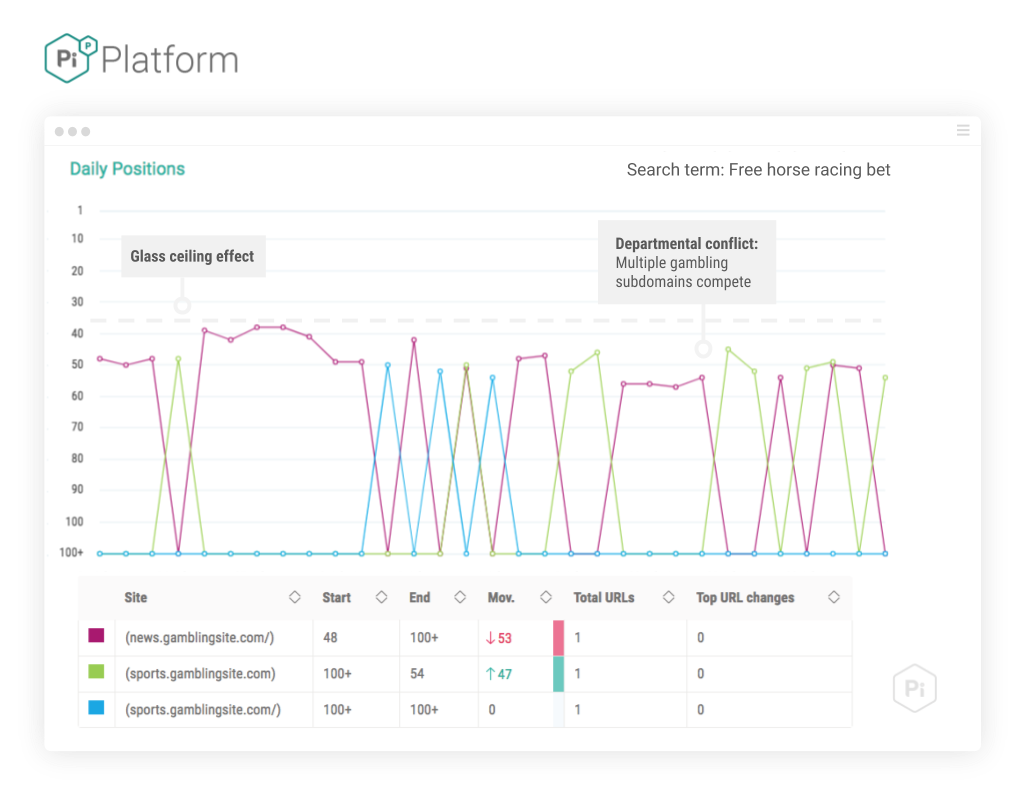 Image source: Pi’s SEO Platform
Image source: Pi’s SEO Platform
This gambling site has three subdomains appearing for the term “Free horse racing bet”. This is three-way subdomain cannibalisation between the news and sports subdomains.

Market value data from the Pi platform shows that this term is commercially quite valuable, yet this isn’t being capitalised on while these three subdomains are essentially sharing visibility in the SERPs. The flux occurring as a result of duplicate theming means no one page is able to rank highly, and therefore a glass ceiling effect is established.
Gambling site drops out of Google UK as five subdomains cannibalise and pop-up site appears
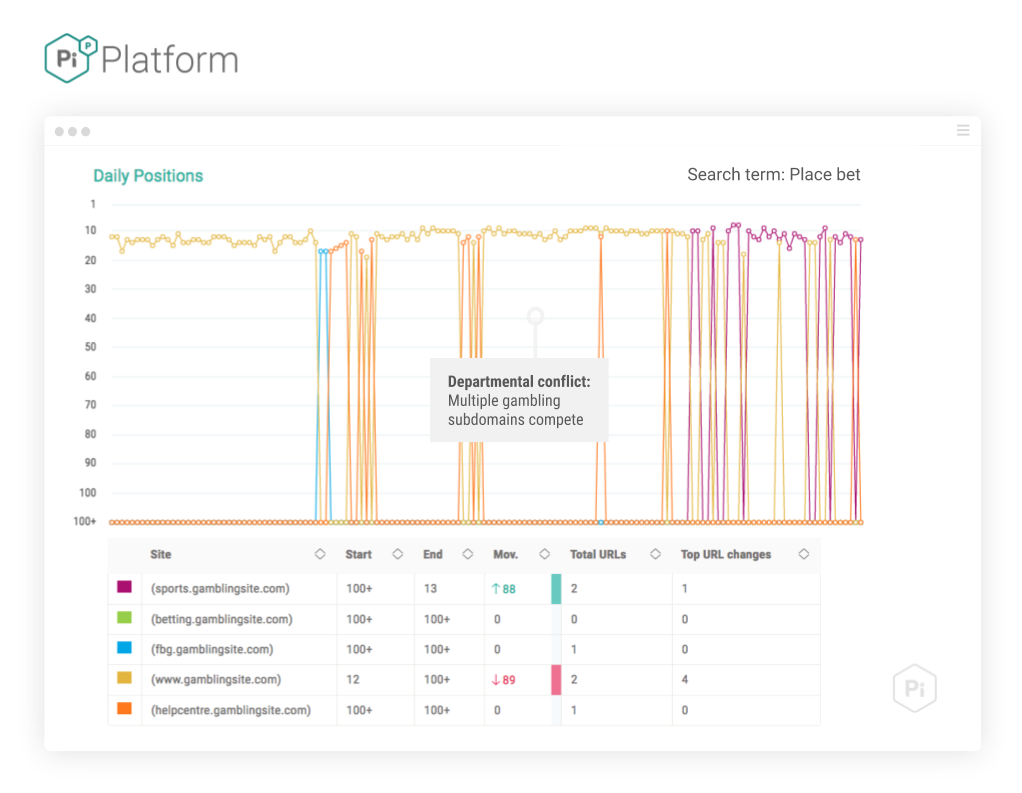 Image source: Pi’s SEO Platform
Image source: Pi’s SEO Platform
Above we see five-way subdomain cannibalisation for the very general term ‘Place bet’. Obviously, this search term could be relevant across many different areas of the corporation, hence the massive conflict. Notice how there is even an FBG subdomain in there, which is a promotional pop-up page.
Service offering subdomain cannibalisation
Example: The Finance sector
As is typical with many businesses that offer both B2B and B2C offerings, they like to separate their services with different assets, designs and tones of voice. The Finance sector is typical of this and especially banks. Here we see a mix up on a major UK bank’s website, where the personal banking subdomain is conflicting with the main site.
Major UK bank loses visibility in Google UK as separate business subdomains cannibalise
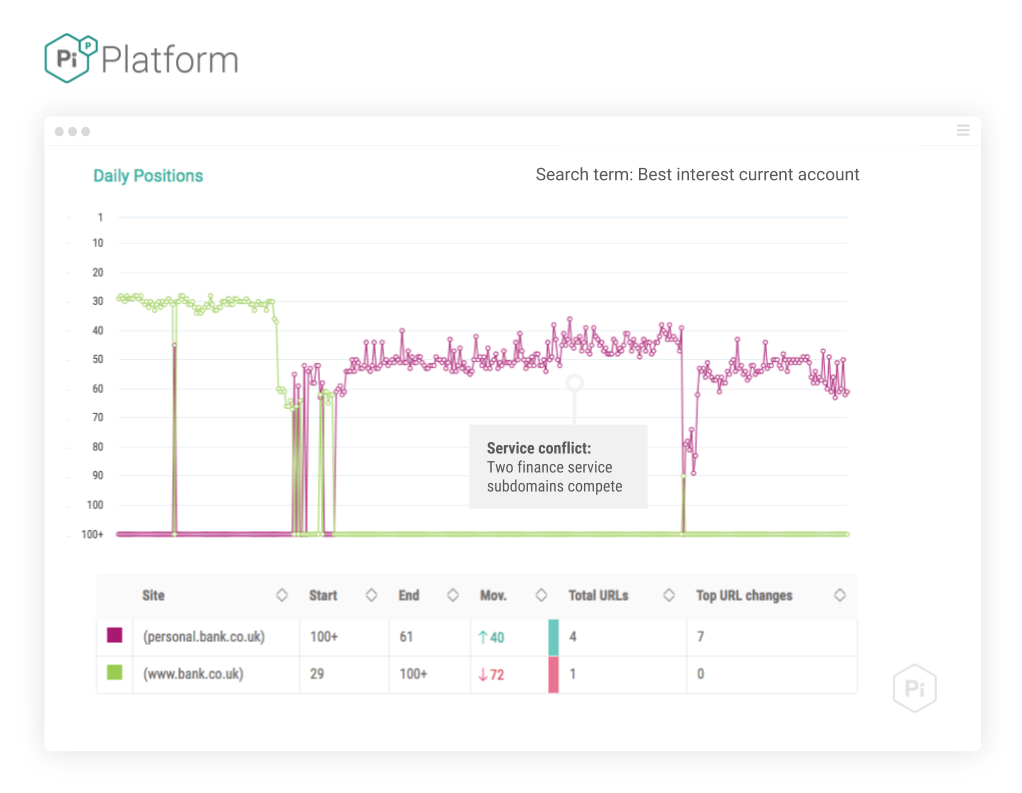 Image source: Pi’s SEO Platform
Image source: Pi’s SEO Platform
Blog subdomain conflict
Example: The Travel sector
As with all sites, putting a blog or a news page on a subdomain can cause major cannibalisation issues with the rest of the site. The news pages have their own internal linking structure, separate tags and menu bars. These major category terms are also likely to appear in the main bulk of the site. So which one does Google choose to be the primary returning page?
This is a difficult area, as on the one hand we are all told that blogs are good and deliver more content. But if they are impeding the rest of the site, including the main category pages, then it’s definitely troublesome.
See how the blog subdomain in the example below is pulling down the main site with this search term ‘Sharm el Sheikh city breaks’
Major airline provider drops out of Google UK as its blog subdomain cannibalises
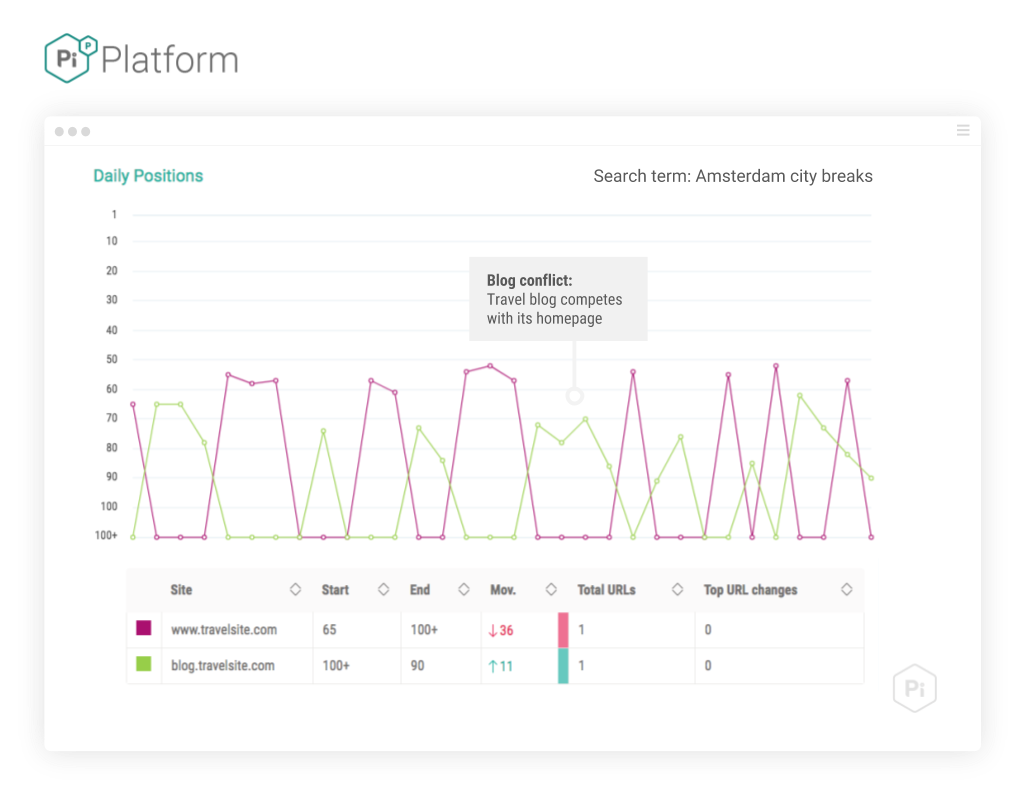 Image source: Pi’s SEO Platform
Image source: Pi’s SEO Platform
Reseller subdomain cannibalisation
Example: The Fashion sector
Many retail companies choose to have a separate domain (usually a subdomain) to re-sell their end-of-line products. The problem with this is that the primary site and the secondary site will be themed similarly to each other. For example, the old product would be a ‘Wax jacket’ and the new one – despite probably being a more contemporary design – would also be a ‘Wax jacket’.
£Multi-million fashion retailer drops out of Google UK as reseller subdomain cannibalises
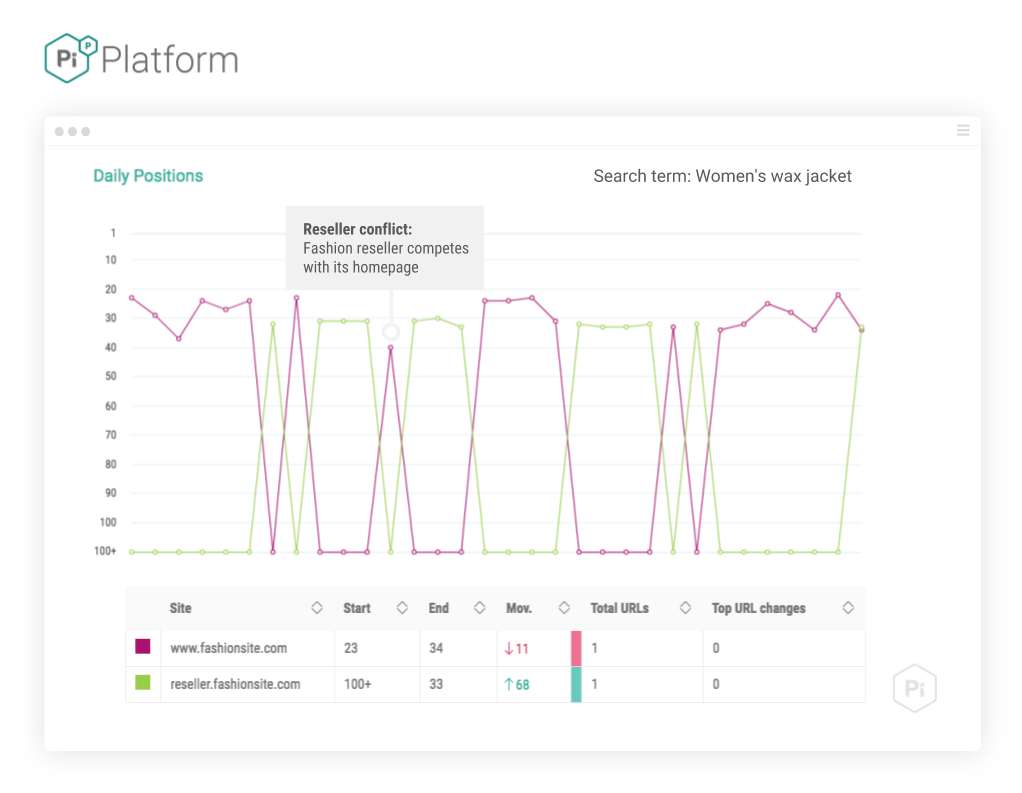 Image source: Pi’s SEO Platform
Image source: Pi’s SEO Platform
In the below example, this major fashion brand is in a right mess with their separate geographical subdomains. This shows the UK site appearing in Google US searches.
Major fashion brand drops out of Google US due to international subdomain conflict
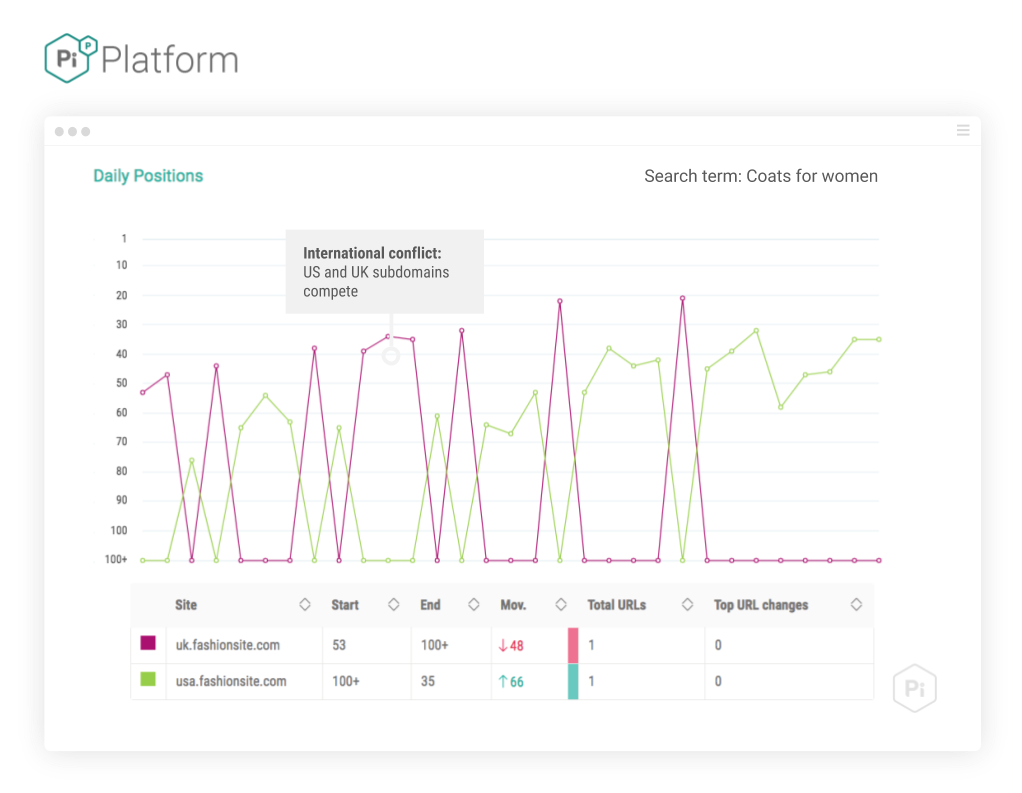 Image source: Pi’s SEO Platform
Image source: Pi’s SEO Platform
Does Google treat subdomains as separate sites?
Google stated, through their spokesman Matt Cutts, that subdomains and subdirectories are “roughly equivalent” – in other words, Google views all as one domain either way. Matt also stated that, in terms of direction on strategy “Whichever one makes you happier, you should go for that one”… But we believe it’s not as simple as that. Employing subdomains with similar theming (even for very top level terms) can seriously damage your performance.
How do you create a successful subdomain strategy?
To avoid dropping out of the conversion zone for your key content, you need to observe and analyse your performance thoroughly. The following actions can help you preserve the value of your content:
1. REVIEW PERFORMANCE DAILY
You need to be monitoring the performance of your subdomains on a daily basis. If you’re only checking in weekly or monthly, you won’t get an accurate enough view of your content ranking. In fact, your subdomain could be outranked for six out of seven days, and you’d be none the wiser if you only had weekly tracking. Daily performance alerts are especially effective when it comes to diagnosing and troubleshooting subdomain cannibalisation, as you can mitigate risk instantly – meaning no dropping out of the conversion zone, and no loss in revenue.
2. MONITOR UNLIMITED URLS
If you could only track domains, it would be impossible to identify subdomain cannibalisation. It’s, therefore, imperative that you monitor every domain, subdomain, folder and directory, to identify threats to performance.
3. TRACK THE TOP 100
You need to have a top-level view over your market for your key terms, to see whether your content is cannibalising itself or losing visibility as a result of another affecting factor.
4. OBSERVE UNLIMITED COMPETITORS
If you are able to rule out subdomain cannibalisation, you need to be able to see whether your competitors are usurping you with stolen content.
5. ACCESS HISTORICAL DATA
Using historical data can be extremely useful in helping you to understand prior subdomain conflict patterns, for future content optimisation and conflict mitigation.
To diagnose this type of cannibalisation, you need to be monitoring your performance on a daily basis, with a view over all possible URLs affected. Only then can you know whether it’s your own content that’s the issue.
Pi can help you identify subdomain conflict in all its forms and varieties, by giving you all the above data across any global market – so even if your international subdomains are cannibalising each other, you can spot the drop and consequently address your content optimsation.
Cannibalisation: Your complete guide
Here’s a video of Jon Earnshaw speaking about cannibalisation in 2013. We’ve been doing this for ages!
If you think your site has been affected by subdomain cannibalisation, book a demo to find out how Pi can help.
Demo the software today
Never miss a post
Join our mailing list and have our SEO news delivered straight to your inbox.
Never miss a post
Join our mailing list and have our SEO news delivered straight to your inbox.

